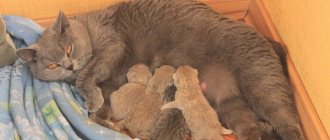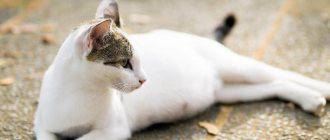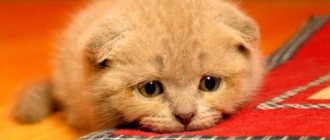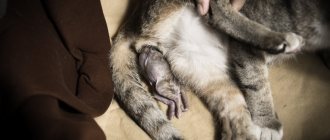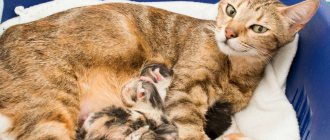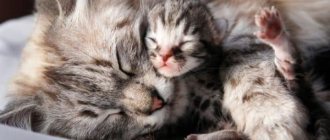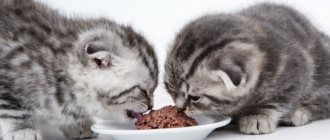Article from the portal: zen.yandex.ru/ivethelp
The cat's excellent health is characterized by a moist, cool nose, a good appetite and a cheerful state. If a cat has a hot nose, the owner begins to worry and sound the alarm. But there is no need to panic, because the cause of a nose that is hot to the touch may not be colds or infectious diseases, but some factors that do not have a detrimental effect on the body.
A cat may have a hot nose immediately after waking up, and also for some time after sleep. Also, changes in temperature on the nose are noted in domestic cats after active physical activity or stressful situations.
Changes in the condition of the pet's nasal surface are also associated with environmental air. So, indoors, especially during cold periods, when the heating is on, the air may be too dry, which leads to drying out of all the outer mucous membranes, causing a rise in temperature.
Hyperthermia that persists for 2-3 hours, accompanied by changes in the animal’s condition (runny nose, shortness of breath, cough, eruption of gastric contents or diarrhea), requires contacting a veterinarian, as this may indicate the onset of a serious illness.
How cats give birth
Inexperienced owners have a vague idea of exactly how childbirth occurs in cats. This is a rather long process, starting with the anxiety of the expectant mother and ending with feeding the babies. Several hours pass between these events. At every stage of labor, it is recommended to be close to the woman in labor, or at least monitor her condition. You should always remember that a cat can die during childbirth.
Pet behavior
About two to three days before contractions, the cat's body temperature drops to 37°C. The mammary glands enlarge and become hotter. Despite the physiological characteristics, the owners first of all notice how the cat behaves before giving birth. Typically, a long-awaited event is heralded by four behavioral features.
- Washing. About two days before labor begins, the genitals become swollen and pink. The cat begins to actively lick itself. There should be no allocations.
- Activity. If a cat suddenly gets bored, becomes detached and apathetic, it means that it will be resolved very soon. Do not disturb your pet during this period.
- Appetite. There is often a decrease in appetite. Your pet may not eat anything the day before giving birth. Provide her with drinks as usual.
- Arching. A few hours before contractions, “training” occurs. There are no noticeable contractions yet, but the animal is already arching (hunching over), as during contractions. This is caused by short-term contractions of the uterus. The cat becomes active, restless, loud, and scared. It can get into hard-to-reach places, so it is recommended to limit your personal space. From now on, stay close to your pet while waiting for the birth.
A cat that is strongly attached to its owner will follow him around and scream. It's not just about attracting attention. The pet is in pain, uncomfortable, and is looking for protection and support. It is important to be close to your pet, stroke it, and talk affectionately.
Start of the process
The main signs of the onset of labor in a cat are contractions. Uterine contractions begin several hours before birth and gradually increase. If the spasms can be detected with a palm placed on the stomach, it means that the cat will give birth very soon. Take your pet to the maternity area, calm her down and prepare everything necessary.
Five signs that labor has begun:
- the stomach drops and becomes pear-shaped;
- urination becomes more frequent - the cat goes to the toilet atypically often;
- mucus is secreted - the birth plug in cats comes off in about 24-48 hours;
- the water breaks - the owner may not notice, since the cat quickly sucks up;
- breathing quickens - the cat opens its mouth and breathes frequently with shortness of breath.
Within two hours after strong contractions, the first baby should appear. If your cat has been pushing unsuccessfully for three hours or more, or if an unpleasant-smelling brown fluid is coming out of the vulva, your cat should be taken to the veterinarian. Perhaps the kittens are stuck, lying across, and the cat needs surgery.
If the pregnancy, contractions and the health of the mother in labor are in order, then there is no need to directly deliver the cat at home. However, you should stay close to monitor the process. A first-time cat may panic and become inattentive. The process of giving birth to a kitten can be divided into five stages.
- Passage through the birth canal. The cat pushes, contracting the muscles of the abdomen and thighs. Usually, four to five pushes are enough for the baby to appear.
- Exit outside. The kitten is born in the amniotic sac or its remains. The bubble may burst when pushing, and then a yellowish liquid is released from the vulva. A few hours before birth (you can see the belly moving), kittens usually “line up” in the uterine horns with their muzzles towards the birth canal. But not all fruits have time to do this. Therefore, kittens can be born with their heads and hind legs first.
- Breathing stimulation. The mother bursts the bubble, licks the kitten, freeing the airways from mucus. A squeaking baby is a good sign, it means he is breathing.
- Umbilical cord rupture. The mother gnaws the umbilical cord and eats the afterbirth. Make sure that all the placenta comes out according to the number of kittens. To be sure of your calculations, write it down on a piece of paper. Placenta remaining in the womb can lead to infectious diseases. If there are a lot of kittens, let the cat eat two or three afterbirths, no more. The placenta contains hormones, which is good for pushing and lactation, but can provoke vomiting or cause diarrhea.
- Lactation. Immediately after birth, the kitten attaches itself to its mother's nipple. The cat must accept its baby and start licking it. With multiple births, labor continues.
It happens that a cat, in pain and busy with itself, crushes the newborn kitten or leaves a baby in the amniotic sac. Actions that the mother did not do must be done by the owner for her.
How long labor lasts depends on the number of kittens and the intensity of pushing. Usually all babies are born within six hours. In order not to “forget” anyone, it is recommended to give your cat an ultrasound during pregnancy. The owner will know exactly how many babies are left and will worry in time if labor suddenly stops.
The final stage
The cat's labor ends with the absence of contractions for two hours. The cat calms down, the pushing stops, the stomach drops and becomes soft. Babies begin to actively suck milk. The behavior and physical condition of the mother after childbirth is characterized by the following signs:
- cares for the babies, licks them, feeds them;
- breathes evenly;
- wants to eat and drink;
- wants to go to the toilet;
- changes position in the birthplace.
You should not immediately start feeding your cat after giving birth. Offer your pet water or milk. If the placenta has been eaten, the mother can remain in the “nest” for up to six hours and not eat anything. Place a bowl near the birthing area and feed the mother four to five times a day with regular food. Add milk, cereals, and fish oil to your diet. Place a tray nearby so that the mother is not away from the cubs for a long time.
It is not recommended to touch babies often, otherwise the mother will lose contact with them. After giving birth, move the mother and kittens to soft bedding and clean up the birthing area. Wipe the box with a cloth and change the diaper. Carefully return the family to their place and leave them alone.
We recommend reading: Congestive Prostatitis in a Dog: How to Treat it
Complications during childbirth and the postpartum period
After the cat bursts the bubble, it begins to actively lick the kitten, which stimulates its respiratory activity. Normally, newborn kittens squeak and move actively. A cat may give birth to still kittens. The chances of salvation depend on the reasons for which the complications occurred. Most often, a kitten does not breathe after birth for the following reasons:
- The cat does not lick the kitten - in order for the lungs to open, it is necessary to remove mucus from the nose and mouth. By licking, the cat actively stimulates blood circulation. If the mother does not show interest in the kitten, you will have to perform resuscitation.
- Prolonged labor - the kitten may die if it remains in the birth canal for a long time. Regardless of the duration of the effort, the death of a kitten is considered clinical, that is, it needs to be assisted.
- The death of a kitten in the womb - in this case, the liquid in the bladder has a pungent odor, and the kitten is born cold with inactive limbs. In this case, no help is provided, since the kitten is already brain dead.
Most cats carry kittens and give birth without difficulty. However, some complications can occur both immediately after birth and throughout the entire period of breastfeeding.
Lack of milk is a common problem in cats that have given birth for the first time. Most often, disorders are caused by an unbalanced diet, vitamin deficiency or dehydration. The following signs may indicate a lack of milk:
- Kittens do not gain weight, behave restlessly, squeak for a long time and loudly.
- The cat gets nervous and leaves the nest.
- The cat eats a lot, but does not gain weight at all.
What to do if there is not enough milk? Depending on the condition of the cat, there are two options: supplement the kittens with a milk replacer or completely transfer the babies to artificial feeding. The cat's diet must be balanced and enriched with calcium products. It is important to make sure that your pet is not dehydrated. When lactation normalizes, artificial feeding can be stopped.
Galactostasis (lactostasis) is a common disorder in primiparous cats and in small pregnancies. The condition is caused by swelling and inflammation of one or more mammary glands, due to stagnation of milk. The following signs indicate the development of galactostasis:
- The cat is restless while feeding.
- One or more breasts become hard and tender.
- The pet's condition is alleviated if the nipple is warmed and massaged so that the stagnant milk comes out.
Mastitis is characterized by:
- Severe swelling of the affected mammary glands.
- Acute pain and a noticeable increase in body temperature (locally at the beginning, then general).
- The cat begins to avoid the kittens and does not feed them.
- The cat experiences apathy and a sharp decrease in appetite.
During the early stages of mastitis, the cat continues to feed her kittens. In most cases, kittens become infected with a bacterial infection, which results in lethargy, stunted growth and increased body temperature. If the situation is ignored, the kittens die, and the cat develops purulent mastitis.
Postpartum eclampsia is an insidious complication that is observed in primiparous cats. Eclampsia is often called milk fever because the cat rapidly loses calcium, resulting in hypocalcemia. Symptoms of eclampsia:
- Fever.
- Lack of appetite.
- Severe anxiety.
- Frequent and heavy breathing.
READ Tetravit for cats drug review
If eclampsia is ignored, the condition becomes severely and quickly complicated. The cat lies down and does not respond to the name, at the same time you can observe:
- Pallor and cyanosis of the mucous membranes.
- Profuse salivation.
- Cramps, spasms.
- Disorders of the central nervous system - loss of balance, lack of coordination of movements.
Eclampsia is an acute, deadly condition that will kill a cat within a few hours. The condition is treated with calcium supplements and general supportive therapy. During treatment, kittens are removed from their mother and transferred to artificial feeding.
Metritis is another insidious complication caused by incomplete expulsion of embryos or placenta from the uterus. During the first birth, the cat may not have enough strength, which will lead to the cessation of contractions and pushing. The cervix closes, although the embryo or afterbirth remains in the cavity. Literally within a day, inflammation develops, which is accompanied by the following symptoms:
- Fever.
- Loss of appetite.
- Ignoring kittens.
- Lethargy and apathy.
- Vaginal discharge that has a strong odor or is green in color.
The condition is relieved by stimulation of labor, and if more than a day has passed, by surgery. A cat is guaranteed to die if the symptoms of metritis are ignored!
Symptoms that should alert you
Any of the above violations does not arise out of the blue. A number of factors that have a negative impact on a cat’s health lead to the development of pathologies:
- poor nutrition and insufficient drinking;
- ignoring regular vaccination and anthelmintic schedule;
- mechanical damage to internal organs due to trauma (for example, rupture of the bladder wall when falling from a height);
- the pet has advanced chronic diseases of the heart, kidneys and other internal organs.
My cat has a very big belly. She's not pregnant, what is it?
Voluntary is explained by volitional muscle contraction when the animal is afraid or does not want to be touched. Forced is a reflex reaction that protects the abdominal organs during pain. Forced abdominal hardness is a reason to consult a specialist, because it can be a signal of a serious pathology.
A rounded, protruding belly is most often a sign of obesity if the increase in its volume is accompanied by the deposition of subcutaneous fatty tissue in other parts of the animal’s body. But sometimes you may encounter the fact that a cat has a big belly and a thin back - in such cats you can easily feel and see the ribs, vertebrae and pelvic bones. Why does this happen?
Firstly, an increase in abdominal volume is not always associated with fat accumulation. Secondly, in obese animals visceral fat may accumulate primarily in this area. It is important to distinguish ordinary obesity from a pathological condition.
Some animals are especially prone to accumulating fat in the abdominal area, making it appear very enlarged. Diagnosing such a cat is quite simple - subcutaneous fat will still accumulate in other parts of the body, albeit not in such large quantities, and the animal will not look emaciated.
It’s another matter when an enlarged abdomen is accompanied by cachexia (emaciation) of the animal, and this condition may have several main causes.
Pregnancy
It is not uncommon for cats to lose fat tissue during pregnancy, especially if the number of fetuses is large, the diet contains insufficient nutrients, and the abdominal volume increases greatly in the later stages. In such animals, from a certain age, kittens can be easily palpated through the abdominal wall.
Tumor
Another reason why the cat is thin and has a large belly may be neoplasms of the abdominal cavity. Tumors sometimes develop over years and can remain undetected for a long time, sometimes growing so much that they lead to a visible increase in the volume of the abdominal cavity. A tumor process of this magnitude will necessarily be accompanied by cachexia.
Viral leukemia is a contagious disease of cats that causes the proliferation of lymphoid tissue throughout the body. In some cases, huge tumors can occupy the entire abdominal cavity, and the disease causes exhaustion of the animal. Unfortunately, this disease is not yet curable.
Coronavirus is another extremely dangerous viral disease of cats, which can manifest itself in the form of peritonitis (inflammation of the peritoneum). If the wet form of the disease develops, a large amount of exudate accumulates in the abdominal cavity, the abdomen increases in volume, and touching is painful.
The viral disease is accompanied by other symptoms - intermittent fever, anorexia, growth retardation in kittens, damage to the nervous system and others. The diagnosis is made using special tests using the polymerase chain reaction (PCR).
Along with viral leukemia, feline viral peritonitis is very dangerous: if the disease is not detected in time and treated, it is almost impossible to save the animal.
The owner of the animal needs to carefully monitor the health of his pet and promptly pay attention to changes in his figure. It is important to be able to distinguish an increase in abdominal volume from simple obesity.
When fat deposits can be found in the chest area, you simply need to reconsider the animal’s diet. But if the cat has a large belly and a thin back, ribs and pelvic bones noticeably protrude, then this may be an alarming sign.
Unsterilized cats should first of all exclude the possibility of pregnancy and pyometra. In the second case, only timely operation will help. With the development of viral peritonitis or leukemia, the quality of life of the animal can be improved with timely diagnosis.
Since an enlarged abdomen is one of the symptoms of deadly cat diseases, the sooner an accurate diagnosis is made, the greater the pet’s chance of recovery.
The causes may be different. Therefore, new owners should more carefully study the possible consequences of incorrect actions. So, why does a kitten have a bloated belly? There are quite a lot of options. Let's look at them now.
Unfortunately, most people do not think that the stomachs of small kittens are not adapted to the food that adult cats eat. In this case, tiny pets can be compared to newborn children.
However, they are in no hurry to feed babies with the everyday food of adults, but with kittens the situation is different. It is poor nutrition that is the reason why a kitten gets a big belly.
After all, food simply is not digested in their small stomach.
This problem can be solved very simply. These days, taking care of fur babies has become much easier. The stores sell a huge amount of all kinds of food that are designed for the age of the animals.
Constipation in a kitten
Constipation can also be caused by poor diet. It is quite simple to determine that a kitten has a large belly due to the accumulation of feces. If the cause of bloating is constipation, your pet's stomach will be hard and dense.
We recommend reading: Vitamin complex for large breed dogs against seizures
In this case, it is recommended to purchase special medications that can eliminate the cause of bloating. You can also give the kitten a light massage by rubbing the belly with smooth circular movements. Another good option for eliminating constipation is to feed the animal fermented milk products, which will facilitate easier excretion of feces.
Why does a kitten have a bloated belly? Due to overeating. It is very simple to understand that the stomach is swollen for this very reason. All you need to do is watch your pet. If the animal moves little and sleeps almost the whole day, this means that the problem arose due to overeating. Overfeeding kittens can cause not only a decrease in activity, but also constipation.
Dealing with the problem of overeating is easy. In order for the kitten to receive the right amount of food and vitamins, portions should be prepared correctly. Food should not sit in a bowl 24/7. To correctly calculate the required amount of food, you can contact specialists.
Worms in a pet
The appearance of parasites in a kitten should never be ignored. It is extremely wrong to believe that worms in animals are normal.
If the owner discovers that the kitten has such parasites, it is necessary to take immediate action. To do this, you should contact a veterinarian or simply buy the appropriate drug at a pet store.
Otherwise, the parasites will multiply in the kitten’s intestines, and this can even lead to death.
Gas formation
Why does a kitten have a big belly? The reason for this may be gas formation. However, this phenomenon is temporary and, as a rule, goes away on its own when the kitten goes to the toilet.
You can also help your small pet and try to give him some activated charcoal. To determine that an animal has gas formation, you need to lightly click your finger on the tummy.
If the sound is loud, then most likely the problem is in the gases.
So, the kitten has a big belly. Why does this happen? If your pet is eating properly, but its tummy is still swollen, this may indicate serious illness. It is impossible to determine such a disease by eye. Therefore, pet owners must take their kitten to the veterinarian.
Thus, the cause of bloating can be serious problems with the liver, malignant tumors, improper functioning of the pancreas, as well as abnormalities in the functioning of the immune system. In addition, bloating can be a consequence of an obese kitten. But in this case, not only the pet’s stomach will show discomfort. The kitten itself will become fat and gain significant weight.
Of course, this is not the entire list of possible causes of bloating in a kitten. Only an experienced veterinarian with special equipment can see the full picture. So, if the animal has become lethargic and drowsy, you should pay attention to this and immediately consult a doctor.
Conclusion
Now you know why a kitten experiences bloating and gas. The reasons may be different. The main thing is to correctly identify the disease. Some problems can be dealt with on your own, while others will require medical intervention.
In any case, people who want to have a cute pet should understand that this is a huge responsibility. Therefore, before adopting a kitten, you should learn more about proper nutrition and caring for babies, and only then get a pet. The right approach can help new owners protect the animal from most of the diseases listed above.
Excessive weight can be eliminated by reviewing your diet. The animal is prescribed less high-calorie food and the usual portions are reduced. Daily physical activity is complemented by joint games.
Delayed birth in a cat
Delayed birth can be explained by physiological reasons, as well as by the environment that surrounds the cat. So, in the presence of stress and irritants, a cat can deliberately delay childbirth. For example, deliberate delay in childbirth is often observed among the British.
Some breeds are more prone to overstaying, for example the Scottish and British breeds have a slightly higher risk of overstaying. In Scotland, pregnancy lasts on average 70 days.
Sometimes, when labor has already begun, labor stops due to weak uterine muscles or the size of the fetus. The kitten may be too large or malpositioned so that it does not physically pass through the birth canal. It is very dangerous. In case of sudden cessation of labor, you should contact your veterinarian.
It is worth approaching the birth of a cat with all responsibility, it is better to play it safe and make sure that all actions are correct. Even though a cat is capable of giving birth and caring for kittens on her own, she may sometimes need the help and attention of the most important person in her life.
Causes
The causes of a hard belly in a cat are:
Constipation.
- Intestinal obstruction.
- Worm infestation.
- Pathology of pregnancy.
- Complications after surgery.
- Cholelithiasis.
- Abscess.
- Ascites (accumulation of fluid in the abdominal cavity).
- Peritonitis.
- Poisoning.
- Injury.
- Postpartum complications.
What is the essence of the problem?
Many owners are concerned that their pets have a sagging belly after giving birth and are in no hurry to return to their original state. Is this normal, or are there signs of a serious pathology? Let's find out!
To begin with, we hasten to reassure breeders: in most cases, a sagging belly is not a sign of panic . To understand this, you need to take a brief excursion into the physiology of childbirth. So, during pregnancy, the animal's abdominal cavity will inevitably stretch. This is caused both by the growth and increase in size of unborn kittens, and by the accumulation of large volumes of amniotic fluid.
In primiparous pets, this is much less pronounced, since their abdominal muscles are more rigid. Old cats are a real “standard” in the matter of sagging belly. An animal that has given birth to kittens several times may sometimes sweep the floor with them, especially immediately after giving birth.
This is a completely physiological phenomenon that is difficult to attribute to pathologies.
With age, muscle rigidity sharply worsens, which is why after giving birth a cat’s stomach takes a long and difficult time to return to normal. Kittens actively “sucking” the mother also make their contribution: practice shows that in pets whose cubs have been next to them for more than two months, the belly sag much more, and subsequently it almost never returns to normal. This is easy to verify by looking at any cat that has given birth a lot during its life.
How to recognize the disease?
If the abdomen becomes hard for a short time, this may mean that the cat was frightened and instinctively tensed the abdominal muscles. This condition will pass as soon as the animal calms down. Constipation causes the accumulation of food in the intestines and overstretching of its loops. It is often accompanied by painful spasms, which causes the abdominal wall to involuntarily contract.
If a pregnant cat's abdominal wall is unusually tense, the pet avoids touching, cannot eat and often vocalizes, she may have a pregnancy pathology, for example, spontaneous abortion. If within 36 hours after delivery the cat's belly has not become soft, she has repeated attempts and she does not show attention to the offspring, there is a high probability of unfinished labor. In this situation, emergency assistance from a specialist is required.
A hard belly in a cat after giving birth is often a symptom of pyometra, a purulent-inflammatory disease of the uterus. It occurs with high fever, difficulty breathing, and frequent urination. The pet loses its appetite, its thirst increases, and it lies without moving.
If a cat refuses to eat, loses weight, his fur becomes dull, becomes matted and falls out, and hypertonicity of the peritoneum is caused by constipation, he may be a carrier of worms. Blockage of the intestinal lumen by a lump of parasites causes a life-threatening condition - intestinal obstruction. The pathology is indicated by the absence of bowel movements, frequent vomiting and tense abdominal muscles.
Peritonitis occurs when blood, pus, or other fluids enter the abdominal cavity. Its wall reflexively contracts, the temperature rises, constant vomiting, convulsions, and depression occur. An abdominal abscess is manifested by enlargement and tenderness of the abdomen, hardening of the muscles and can lead to perforation of the organ. With ascites, the abdomen becomes swollen, appetite is suppressed, and persistent pain worries.
Trauma often leads to internal bleeding, which can be suspected by the presence of blood in the stool and urine, and the bluish color of the mucous membranes. If the internal organs have not been damaged, there will be no symptoms other than the hard peritoneum. If a certain area of the abdomen hardens, resembling a lump, a tumor is likely to form.
A hard belly in a cat after sterilization may indicate post-operative swelling, exacerbation of internal diseases, or infection of the suture. If the wound gets infected, phlegmons, abscesses form in this area, and the temperature rises. If granulosa tissue has grown at the suture site, dense localized lumps appear. They do not cause pain to the cat and dissolve on their own over time.
If the abdomen hardens 3-4 weeks after surgery, ligature fistulas are likely to open. In this case, the peritoneum is heterogeneous to the touch, covered with pustules, and skin hyperemia is observed. This condition occurs due to improper postoperative care or injury to the sutures by the cat itself. Gallstones can cause a hard belly in a cat. The skin and mucous membranes become jaundiced, and an attack of colic causes aggression and anxiety.
We recommend reading: Cat Aret
Why is a saggy belly dangerous?
Hypothetically, nothing bad will happen to your “saggy” pet. But it's still better to be safe. Thus, the dense and elastic layer of the peritoneum is the natural protection of both the uterus and the babies in it. Accordingly, older cats with stretched, saggy bellies are at an extremely high risk of a variety of injuries. Of course, you are unlikely to be able to protect your pet from troubles 100%, but it is still possible to reduce their likelihood (provided you carefully follow simple rules).
So, when the cat’s belly has dropped “indecently low”, we would strongly recommend isolating it in a separate room, from where you should remove all the furniture and try to somehow protect all protruding surfaces. In short, every effort must be made to create an analogue of the “room for violent people” in a mental hospital.
Important! If you have children, be sure to instruct them not to play with a pregnant cat.
When old pets are actively running, they can hit something hard with their saggy belly. The result is a miscarriage (at best), or the death of the animal from massive internal bleeding caused by uterine rupture. An older pregnant cat should be handled with care, as if you were handling a fragile porcelain vase. This way you can minimize risks and help your pet give birth to strong, healthy kittens.
Treatment
The treatment method is determined by the reason why the pet's abdominal wall has hardened. If a cat has constipation and a swollen hard belly, but there are no other health problems, you should exclude meat, liver, dry food from the diet and feed it with vegetable, fermented milk and fish food until the stool normalizes. In cases where constipation in a cat is caused not by errors in feeding, but by a disease, a veterinarian will prescribe treatment. Pyometra detected at the initial stage can be treated with antibiotics. In advanced forms, the only treatment option is surgical removal of the reproductive organs. If an animal has suffered an abdominal injury, it must be urgently taken to a veterinarian to rule out internal injuries and blood loss.
If the cat has ascites, hospitalization is indicated for antibiotic therapy. Treatment of intestinal obstruction and neoplasms is surgical. In case of poisoning by poor-quality food, the cat’s stomach is washed with saline solution or potassium permanganate. If an animal has consumed poison, a specific antidote will be required. Treatment of peritonitis is carried out in a hospital setting.
Most often, bloating in a cat occurs due to poor nutrition. Overeating or using cheap food leads to problems with the digestive system. In other cases, the appearance of an enlarged abdominal cavity is a serious cause for concern. Some causes are so dangerous that they can be fatal.

